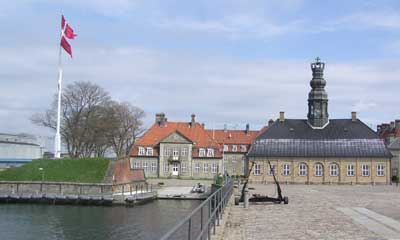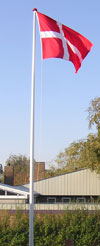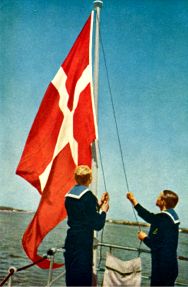|
You are here: 4The Flag |
||||||||||||||||||||||||||||||||||||||||||||
|
|
|||||||||||||||||||||||||||||||||||||||||||
|
Dannebrog |
Dannebrog |
Orlogsflaget |
The swallow-tailed flag is only authorized for use by governmental and public institutions. All others including the merchant nay and private are to use the normal square flag.
Orlogsflaget, the Naval Ensign, is only flying on board ships of the Royal Danish Navy.
|
The main difference between the swallow-tailed "Danne-brog" and the "Orlogsflag" is the color. To the left are the basic colors replicated, as natural as possible. On top is the normal Danish red (RGB #CE1126) and the color (RGB #992135) used for the Naval Ensign (Orlogsflaget) is shown below. |
|
A number of organizations, companies etc. have by royal resolution been a allowed to use one of the flags with the special insignia, normally incorpo-rated in the upper left square of the flag.
The Danish Sovereign Flag
For centuries the flag has been the symbol of the King; the national sign of sovereignty.
Later on, the Danish flag placed on the bastions in front of the Kronborg Castle became a symbol to which foreign ships had to fire a salute, when entering Danish waters.

The
Sovereign Flag flying from
Holmen in Copenhagen.
(Photo: Johnny Balsved)
The Danish Sovereign Flag has since 1788 been flying on the SIXTUS bastion in Copenhagen.
Banner or Flag
The Banner, or the Standard, was in ancient days the primary way of showing the Colors.
The Banner was the symbol of the King.
Later on, one could see the Flag flying from His Majesty's ships.
The Navy and the Colors
The Navy and the Colors have always been closely related. Main parts of the day to day job of the Navy was to fly the colors, or more exactly demonstrating the sovereignty.
|
However, the ships of the Royal Danish Navy do not fly the Dannebrog. Instead the Navy flies the Naval Ensign or, in Danish, the Orlogsflaget. The Orlogsflaget is a swallow tailed flag and has a deeper red color than the Dannebrog. Despite the increasing sophistication of technology in the Royal Danish Navy, the traditions surrounding "The colors of the Fleet" are still maintained. The importance of representing the Danish nation and the Sovereign in our maritime organizations is as great as it ever was, and flags provide both the tradition and obvious way of doing this. Flags have always had an important part to play at sea, to pass messages, to identify another nation's ships or their occupants, to warn of danger, and for many other purposes. |
The Naval
Ensign, |
Today's flag provide a very useful means of identification and the traditions surrounding Naval flags remain firmly part of the life of the Royal Danish Navy.
|
Sources: |
||
|
& |
Fra Flaadens arkiver - Dannebrog fra kongebanner til orlogsflag og fane, by Commander s.g. Th. Bjerre, Vaabenhistorisk Selskab, Copenhagen 1958 |
|
|
& |
Om Dannebrog jeg ved..., edited by Jesper Hjermind and Kristian Melgaard, Forlaget Viborg I/S, Viborg, 1995 (ISBN 87-90281-00-4) |
|
|
& |
Rigets Flag paa batteriet Sixtus 1788 - 15.8 . 1988, by H. C. Bjerg, published by the Naval Material Command, Copenhagen, 1988 |
|
|
& |
Vort flag, Forlaget Codan, Copenhagen 1943 |
|
|
44You are also referred to the Naval Bibliography
- Do you miss a major event on this Site,
Are you able to contribute to the unfolding of
the Danish Naval History, You can also use the Naval Web Forum on this web-site.
|
||
-
This page was last updated: May 3, 2006
This page was first published: September 16, 2001
Copyright © 2013-2016 Johnny E. Balsved - All rights reserved - Privacy Policy






